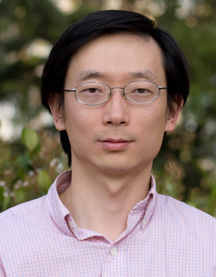

New Global Survey of Protein Regulation Sheds Light on Stem Cells Mechanisms
By Mika Ono and Josh Baxt
Researchers from The Scripps Research Institute and Burnham Institute for Medical Research have unveiled new clues about how stem cells work by conducting a sophisticated profile of their protein activity. The data may help researchers understand the mechanisms that determine whether stem cells divide or differentiate, what types of cells they become, and how to control those complex mechanisms to facilitate development of new therapies.
The study was published in the August 7 issue of the journal Cell Stem Cell.
In the study, the researchers describe their large-scale survey of a specific type of protein activity in human embryonic stem cells, which have the capacity to become many different cell types. The researchers then compared this profile to a similar survey of "differentiated" cells (cells that have changed into specific cell types, such as skin, bone, hair, etc.) derived from these stem cells.
"This work provides the first really global view of protein regulation in human embryonic stem cells," says Scripps Research Associate Professor Sheng Ding. "Our study provides a significant body of new information that scientists can now follow up in detail to move us closer to the development of stem cell therapies."
The type of analysis used in the new research, called "phosphoproteomic analysis," identifies the location of protein phosphorylation, the biochemical process that modifies protein activities by adding a phosphate molecule. This process is central to cell signaling. By identifying and comparing these phosphorylation sites, the researchers aimed to provide insights into the signaling mechanisms that drive stem cell behavior.
Using methods including multi-dimensional liquid chromatography and tandem mass spectrometry, the team catalogued 2,546 phosphorylation sites on 1,602 phosphoproteins.
"This research will be a big boost for stem cell scientists," said Laurence M. Brill, senior scientist at Burnham's Proteomics Facility and an author of the new paper with Ding, Evan Snyder, professor and director of Burnham's Stem Cells and Regenerative Medicine program, and colleagues. "The protein phosphorylation sites identified in this study are freely available, and researchers can use this data to study the cells in greater depth and determine how phosphorylation events determine a cell's fate."
The new study provides researchers in the field with many potentially useful details. For example, the research found many transcription regulators such as epigenetic and transcription factors, as well as a large number of kinases, are phosphorylated in human embryonic stem cells, suggesting that these proteins may play a key role in determining stem cell fate. Proteins in the JNK signaling pathway were also found to be phosphorylated in undifferentiated human embryonic stem cells, suggesting that inhibition of JNK signaling may lead to differentiation.
In addition, the study showed that phosphoproteomic analysis was useful for discovering novel proteins relevant to the cells. For example, the team found that phosphoproteins in receptor tyrosine kinase (RTK) signaling pathways were numerous in undifferentiated human embryonic stem cells. Follow-up studies showed that multiple RTKs support human embryonic stem cells in their undifferentiated state.
After conducting the global surveys, the research team demonstrated the utility of the data as a predictive tool by targeting a sample of signaling pathways revealed in the human embryonic stem cells. Follow-up experiments confirmed the relevance of these phosphoproteins and pathways to the cells.
In addition to Ding, Brill, and Snyder, other authors of the paper, "Resource Phosphoproteomic Analysis of Human Embryonic Stem Cells," are Wen Xiong of Scripps Research, Ki-Bum Lee of Scripps Research (now at Rutgers University), Scott B. Ficarro of Genomics Institute of the Novartis Research Foundation (GNF) (now at Dana Farber Cancer Institute), Andrew Crain of Burnham and the University of California, San Diego, Yue Xu of Scripps Research, and Alexey Terskikh of Burnham. The protein phosphorylation data is available on the Cell Stem Cell website, http://www.cell.com/cell-stem-cell/abstract/S1934-5909(09)00286-0, as well as on the PRIDE website, http://www.ebi.ac.uk/pride.
Support for this research was provided by the National Institutes of Health, a postdoctoral fellowship from the California Institute for Regenerative Medicine, and GNF.
Send comments to: mikaono[at]scripps.edu

"Our study provides a significant body of new information that scientists can now follow up in detail to move us closer to the development of stem cell therapies," says Associate Professor Sheng Ding.
